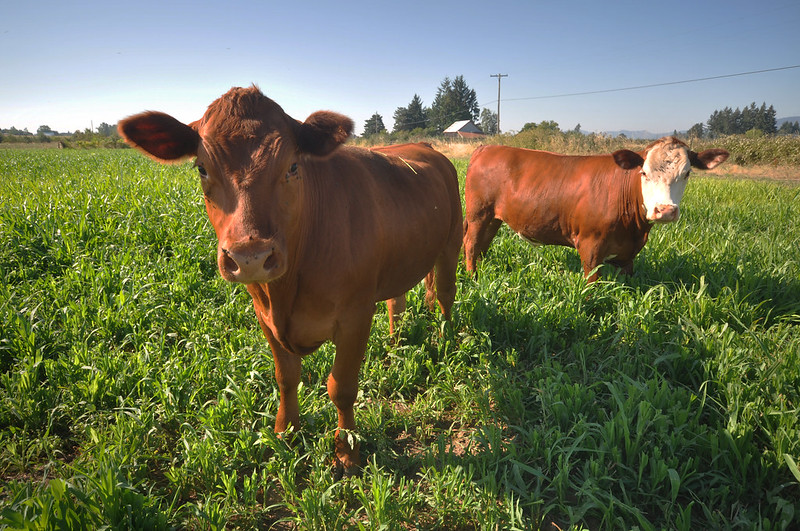Advancing Sustainable Livestock Production
The ARS food animal production research program improves food animal production efficiency, sustainability, animal welfare, and product quality while safeguarding animal genetic resources. ARS scientists are using genomic technologies to enhance selection and develop livestock that have resistance to diseases and parasites and are better suited to different environments. Raising livestock is an effective way to use the resources of many rangeland areas that are not suitable for other purposes such as raising crops or other agricultural activities. The following accomplishments highlight ARS advances in animal production research in 2021.
Rapid eye temperature measurement to evaluate animal health. Rapid temperature measurement using forehead thermometers has become normal practice for humans, but current practices in cattle rely on obtaining rectal temperatures, which is time-consuming. ARS scientists in Lubbock, Texas, and university collaborators studied infrared ocular thermography, measuring the temperature of the eye, to detect fever in cattle. Results indicate that infrared ocular thermography can detect fever in cattle in less than 30 seconds and that eye temperature is highly correlated with rectal temperature. Adopting this rapid method for detecting fever in cattle allows high-throughput measurement in production facilities that will improve cattle management and sickness identification practices, improve cattle well-being and productivity, and reduce production costs.
A swine-origin H3N2 influenza virus closely related to human H3N2v demonstrated transmission from swine to ferrets. The transmission of influenza A viruses (IAV) from swine to humans occurs sporadically and is often associated with U.S. agricultural fairs. IAVs from swine that are detected in humans are called "variant" to differentiate from human seasonal IAV. During the 2016-2017 influenza season, 61 H3N2 variant (H3N2v) cases were reported. ARS scientists in Ames, Iowa, compared the genomes of human H3N2v viruses and swine H3N2 viruses collected at the same 2017 state fair in Ohio, where ferrets were also directly infected with the H3N2 virus. In the study, pigs were infected with the virus and placed in an enclosure close to caged ferrets, which were chosen to test the spread of H3N2 because IAV transmission and infection in ferrets serves as model for human IAV transmission and infection. Results demonstrated that the swine H3N2 replicated in both pigs and ferrets exposed to the respiratory aerosols of infected pigs, showing potential transmission from pigs to susceptible ferrets. These results are the first to show a transmission model from swine to ferrets without modification to the virus and highlight the need to reduce swine IAV at animal exhibits. This study also demonstrates the importance of continued surveillance, research, and collaboration on swine and human IAV.
House flies can harbor SARS-CoV-2 but do not transmit infectious virus. The SARS-CoV-2 virus, responsible for the COVID-19 pandemic, is highly contagious and typically transmitted via respiration, but the possibility of transmission following contact with contaminated items cannot be dismissed. ARS scientists in Manhattan, Kansas, and Kansas State University collaborators explored if house flies could acquire and transmit the SARS-CoV-2 virus. Flies were exposed to SARS-CoV-2-spiked culture media or SARS-CoV-2-spiked milk substrates and then tested for the virus at either 4 or 24 hours after exposure. All flies exposed to inoculated media or milk carried viral RNA at 4 hours and 24 hours post-exposure, but infectious virus detection occurred only in the virus-spiked milk group. In a second experiment, flies exposed to SARS-CoV-2 for 24 hours were transferred to a clean container, and no infectious virus was detected. Results showed house flies can carry SARS-CoV-2 for up to 24 hours post-exposure, but do not transmit the virus due to quick clearing of the infectious virus in laboratory settings. While house flies likely do not play an important role in SARS-CoV-2 transmission, field-trapped house flies could potentially be used for virus surveillance.
ARS leads research to improve agricultural nutrient management and environmental quality. Nitrogen is an essential nutrient for crop production in modern agricultural systems. However, nitrogen losses to the atmosphere as nitrous oxide (N2O) and ammonia (NH3) can impair air quality and contribute to climate change. ARS researchers in Kimberly, Idaho, generated a comprehensive dataset of ammonia emissions from dairy facilities to identify the magnitude and origin of emissions and potential mitigation strategies. These data were used to improve farm emission estimates from the Dairy CropSys and Integrated Farm System models; are being included in a tool developed by the Global Research Alliance database, the DATAMAN; and are being provided to the U.S. EPA to improve ammonia emission estimation methodologies during manure storage. In related research, ARS scientists in Auburn, Alabama, used satellite-based modeling to assess how national changes in NH3 and N2O emissions over 14 years are linked to nitrogen fertilizer application, livestock manure production, and climate factors. Atmospheric NH3 concentrations were positively correlated with surface temperature in five U.S. regions, with the highest found in the Mid-South. Estimates also suggest global cropland N2O emissions increased by 180 percent during 1961-2014, with nitrogen fertilizer responsible for ~70 percent of total emissions during 2000-2014. This monitoring and modelling research is being provided to programmatic and policy agencies to help develop mitigation strategies and improve environmental outcomes related to nitrogen fertilizer practices.
 To build soil health, cattle graze cover crops on land not currently in vegetable production at Square Peg Farm, which is a certified organic produce farm located near Forest Grove, Oregon. 2014. USDA Photo. https://flic.kr/p/2nfx52B
To build soil health, cattle graze cover crops on land not currently in vegetable production at Square Peg Farm, which is a certified organic produce farm located near Forest Grove, Oregon. 2014. USDA Photo. https://flic.kr/p/2nfx52B

 DOWNLOAD TWO-PAGER PDF
DOWNLOAD TWO-PAGER PDF